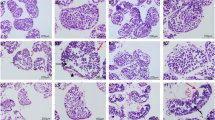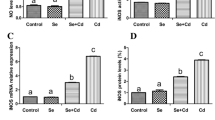Abstract
Cadmium (Cd) is an ubiquitous environmental pollutant that has been associated with male reproductive toxicity in animal models. However, little is known about the reproductive toxicity of Cd in birds. To investigate the toxicity of Cd on male reproduction in birds and the protective effects of selenium (Se) against subchronic exposure to dietary Cd, 100-day-old cocks received either Se (as 10 mg Na2SeO3 per kg of diet), Cd (as 150 mg CdCl2 per kg of diet) or Cd + Se in their diets for 60 days. Histological and ultrastructural changes in the testis, the concentrations of Cd and Se, amount of lipid peroxidation (LPO), the activities of the antioxidants superoxide dismutase (SOD) and glutathione peroxidase (GPx), and apoptosis and serum testosterone levels were determined. Exposure to Cd significantly lowered SOD and GPx activity, Se content in the testicular tissue, and serum testosterone levels. It increased the amount of LPO, the numbers of apoptotic cells and Cd concentration and caused obvious histopathological changes in the testes. Concurrent treatment with Se reduced the Cd-induced histopathological changes in the testis, oxidative stress, endocrine disorder and apoptosis, suggesting that the toxic effects of cadmium on the testes is ameliorated by Se. Se supplementation also modified the distribution of Cd in the testis.




Similar content being viewed by others
References
Acharya UR, Mishra M, Patro J, Panda MK (2008) Effect of vitamins C and E on spermatogenesis in mice exposed to cadmium. Reprod Toxicol 25(1):84–88
Anteau MJ, Afton AD, Custer CM, Custer TW (2007) Relationships of cadmium, mercury, and selenium with nutrient reserves of female lesser scaup (Aythya affinis) during winter and spring migration. Environ Toxicol Chem 26(3):515–520
Belyaeva EA, Dymkowska D, Wieckowski MR, Wojtczak L (2008) Mitochondria as an important target in heavy metal toxicity in rat hepatoma AS-30D cells. Toxicol Appl Pharmacol 231(1):34–42
Boitani C, Puglisi R (2008) Selenium, a key element in spermatogenesis and male fertility. Adv Exp Med Biol 636:65–73
Bonda E, Wlostowski T, Krasowska A (2004) Testicular toxicity induced by dietary cadmium is associated with decreased testicular zinc and increased hepatic and renal metallothionein and zinc in the bank vole (Clethrionomys glareolus). Biometals 17(6):615–624
Bradford MM (1976) A rapid and sensitive method for the quantitation of microgram quantities of protein utilizing the principle of protein-dye binding. Anal Biochem 72:248–254
Burukoğlu D, Baycu C (2008) Protective effects of zinc on testes of cadmium-treated rats. Bull Environ Contam Toxicol 81(6):521–524
Chen L, Liu L, Huang S (2008) Cadmium activates the mitogen-activated protein kinase (MAPK) pathway via induction of reactive oxygen species and inhibition of protein phosphatases 2A and 5. Free Radic Biol Med 45(7):1035–1044
Dorta DJ, Leite S, DeMarco KC, Prado IM, Rodrigues T, Mingatto FE et al (2003) A proposed sequence of events for cadmium-induced mitochondrial impairment. J Inorg Biochem 97(3):251–257
El-Ashmawy IM, Youssef SA (1999) The antagonistic effect of chlorpromazine on cadmium toxicity. Toxicol Appl Pharmacol 161(1):34–39
El-Sharaky AS, Newairy AA, Badreldeen MM, Eweda SM, Sheweita SA (2007) Protective role of selenium against renal toxicity induced by cadmium in rats. Toxicology 235(3):185–193
Esterbauer H, Cheeseman KH (1990) Determination of aldehydic lipid peroxidation products: malonaldehyde and 4-hydroxynonenal. Methods Enzymol 186:407–421
Fouad AA, Qureshi HA, Al-Sultan AI, Yacoubi MT, Ali AA (2009) Protective effect of hemin against cadmium-induced testicular damage in rats. Toxicology 257(3):153–160
Hasunuma R, Ogawa T, Kawanishi Y (1982) Fluorometric determination of selenium in nanogram amounts in biological materials using 2,3-diaminonaphthalene. Anal Biochem 126(2):242–245
Heyno E, Klose C, Krieger-Liszkay A (2008) Origin of cadmium-induced reactive oxygen species production: mitochondrial electron transfer versus plasma membrane NADPH oxidase. New Phytol 179(3):687–699
IARC (1993) Beryllium, cadmium, mercury, and exposures in the glass manufacturing industry. IARC Monograph 58, Lyon
Jamba L, Nehru B, Bansal MP (2000) Effect of selenium supplementation on the influence of cadmium on glutathione and glutathione peroxidase system in mouse liver. J Trace Elem Exp Med 13(3):299–304
Jihen el H, Imed M, Fatima H, Abdelhamid K (2008) Protective effects of selenium (Se) and zinc (Zn) on cadmium (Cd) toxicity in the liver and kidney of the rat: histology and Cd accumulation. Food Chem Toxicol 46(11):3522–3527
Jihen el H, Imed M, Fatima H, Abdelhamid K (2009) Protective effects of selenium (Se) and zinc (Zn) on cadmium (Cd) toxicity in the liver of the rat: effects on the oxidative stress. Ecotoxicol Environ Saf 72(5):1559–1564
Kara H, Cevik A, Konar V, Dayangac A, Yilmaz M (2007) Protective effects of antioxidants against cadmium-induced oxidative damage in rat testes. Biol Trace Elem Res 120(1–3):205–211
Kumar P, Prasad Y, Patra AK, Swarup D (2007) Levels of cadmium and lead in tissues of freshwater fish (Clarias batrachus L.) and chicken in Western UP (India). Bull Environ Contam Toxicol 79(4):396–400
Kusakabe T, Nakajima K, Suzuki K, Nakazato K, Takada H, Satoh T, Oikawa M, Kobayashi K, Koyama H, Arakawa K, Nagamine T (2008) The changes of heavy metal and metallothionein distribution in testis induced by cadmium exposure. Biometals 21(1):71–81
Lafuente A, Márquez N, Pérez-Lorenzo M, Pazo D, Esquifino AI (2001) Cadmium effects on hypothalamic-pituitary-testicular axis in male rats. Exp Biol Med (Maywood) 226(6):605–611
Lafuente A, Gonzalez-Carracedo A, Romero A, Cano P, Esquifino AI (2004) Cadmium exposure differentially modifies the circadian patterns of norepinephrine at the median eminence and plasma LH, FSH and testosterone levels. Toxicol Lett 146(2):175–182
Larison JR, Likens GE, Fitzpatrick JW, Crock JG (2000) Cadmium toxicity among wildlife in the Colorado Rocky Mountains. Nature 406(6792):181–183
Lazarus M, Orct T, Blanusa M, Kostial K, Pirsljin J, Beer-Ljubic B (2006) Effect of selenium pre-treatment on cadmium content and enzymatic antioxidants in tissues of suckling rat. Toxicol Lett 164(S1):S191. doi:10.1016/j.toxlet.2006.07.055
Lazarus M, Orct T, Jurasoviae J, Blanusa M (2009) The effect of dietary selenium supplementation on cadmium absorption and retention in suckling rats. Biometals 22:973–983. doi:10.1007/s10534-009-9249-9
Liu J, Corton C, Dix DJ, Liu Y, Waalkes MP, Klaassen CD (2001) Genetic background but not metallothionein phenotype dictates sensitivity to cadmium-induced testicular injury in mice. Toxicol Appl Pharmacol 176(1):1–9
Liu J, Qian SY, Guo Q, Jiang J, Waalkes MP, Mason RP, Kadiiska MB (2008) Cadmium generates reactive oxygen- and carbon-centered radical species in rats: insights from in vivo spin-trapping studies. Free Radic Biol Med 45(4):475–481
Lucia M, Andre JM, Gonzalez P, Baudrimont M, Gontier K, Maury-Brachet R, Davail S (2009) Impact of cadmium on aquatic bird Cairina moschata. Biometals (in press). doi:10.1007/s10534-009-9232-5
Manna P, Sinha M, Sil PC (2008) Cadmium induced testicular pathophysiology: prophylactic role of taurine. Reprod Toxicol 26(3–4):282–291
Messaoudi I, Hammouda F, El Heni J, Baati T, Said K, Kerkeni A (2009) Reversal of cadmium-induced oxidative stress in rat erythrocytes by selenium, zinc or their combination. Exp Toxicol Pathol (in press). doi:10.1016/j.etp.2009.04.004
Newairy AA, El-Sharaky AS, Badreldeen MM, Eweda SM, Sheweita SA (2007) The hepatoprotective effects of selenium against cadmium toxicity in rats. Toxicology 242(1–3):23–30
Ognjanović BI, Marković SD, Pavlović SZ, Zikić RV, Stajn AS, Saicić ZS (2008) Effect of chronic cadmium exposure on antioxidant defense system in some tissues of rats: protective effect of selenium. Physiol Res 57(3):403–411
Pan C, Zheng G, Zhang Y (2008) Concentrations of metals in liver, muscle and feathers of tree sparrow: age, inter-clutch variability, gender, and species differences. Bull Environ Contam Toxicol 81(6):558–560
Pollock B, Machin KL (2009) Corticosterone in relation to tissue cadmium, mercury and selenium concentrations and social status of male lesser scaup (Aythya affinis). Ecotoxicology 18(1):5–14
Roodbergen M, Klok C, van der Hout A (2008) Transfer of heavy metals in the food chain earthworm Black-tailed godwit (Limosa limosa): comparison of a polluted and a reference site in The Netherlands. Sci Total Environ 406(3):407–412
Santos FW, Oro T, Zeni G, Rocha JB, do Nascimento PC, Nogueira CW (2004) Cadmium induced testicular damage and its response to administration of succimer and diphenyl diselenide in mice. Toxicol Lett 152(3):255–263
Santos FW, Zeni G, Rocha JB, Weis SN, Fachinetto JM, Favero AM et al (2005) Diphenyl diselenide reverses cadmium-induced oxidative damage on mice tissues. Chem Biol Interact 151(3):159–165
Sasakura C, Suzuki KT (1998) Biological interaction between transition metals (Ag, Cd and Hg), selenide/sulfide and selenoprotein P. J Inorg Biochem 71(3–4):159–162
Schomburg L, Schweizer U, Holtmann B, Flohe L, Sendtner M, Kohrle J (2003) Gene disruption discloses role of selenoprotein P in selenium delivery to target tissues. Biochem J 370(Pt 2):397–402
Sen Gupta R, Kim J, Gomes C, Oh S, Park J, Im WB, Seong JY, Ahn RS, Kwon HB, Soh J (2004a) Effect of ascorbic acid supplementation on testicular steroidogenesis and germ cell death in cadmium-treated male rats. Mol Cell Endocrinol 221(1–2):57–66
Sen Gupta R, Sen Gupta E, Dhakal BK, Thakur AR, Ahnn J (2004b) Vitamin C and vitamin E protect the rat testes from cadmium-induced reactive oxygen species. Mol Cells 17(1):132–139
Siu ER, Mruk DD, Porto CS, Cheng CY (2009) Cadmium-induced testicular injury. Toxicol Appl Pharmacol (in press). doi:10.1016/j.taap.2009.01.028
Stadtman TC (2000) Selenium biochemistry. Mammalian selenoenzymes. Ann N Y Acad Sci 899:399–402
Takiguchi M, Yoshihara S (2006) New aspects of cadmium as endocrine disruptor. Environ Sci 13(2):107–116
Waalkes MP (2000) Cadmium carcinogenesis in review. J Inorg Biochem 79(1–4):241–244
Wayland M, Gilchrist HG, Marchant T, Keating J, Smits JE (2002) Immune function, stress response, and body condition in arctic-breeding common eiders in relation to cadmium, mercury, and selenium concentrations. Environ Res 90(1):47–60
Xu LC, Sun H, Wang S, Song L, Chang HC, Wang XR (2005) The roles of metallothionein on cadmium-induced testes damages in Sprague-Dawley rats. Environ Toxicol Pharmacol 20:83–87
Yadav N, Khandelwal S (2008) Effect of Picroliv on cadmium induced testicular damage in rat. Food Chem Toxicol 46(2):494–501
Yang JM, Arnush M, Chen QY, Wu XD, Pang B, Jiang XZ (2003) Cadmium-induced damage to primary cultures of rat Leydig cells. Reprod Toxicol 17(5):553–560
Yiin SJ, Chern CL, Sheu JY, Lin TH (1999) Cadmium induced lipid peroxidation in rat testes and protection by selenium. Biometals 12(4):353–359
Yu RA, Chen XM (2004) Effects of selenium on rat hepatocellular DNA damage, apoptosis and changes of cell cycle induced by cadmium in vivo. Zhonghua Yu Fang Yi Xue Za Zhi 38(3):155–158
Yu X, Hong S, Faustman EM (2008) Cadmium-induced activation of stress signaling pathways, disruption of ubiquitin-dependent protein degradation and apoptosis in primary rat Sertoli cell-gonocyte cocultures. Toxicol Sci 104(2):385–396
Zhou YJ, Zhang SP, Liu CW, Cai YQ (2009) The protection of selenium on ROS mediated-apoptosis by mitochondria dysfunction in cadmium-induced LLC-PK(1) cells. Toxicol In Vitro 23(2):288–294
Acknowledgment
This work was supported by a grant from the Bureau of Education of Heilongjiang Province (No. 10551038).
Author information
Authors and Affiliations
Corresponding author
Additional information
Jin-Long Li and Rui Gao contributed equally to this work.
Rights and permissions
About this article
Cite this article
Li, JL., Gao, R., Li, S. et al. Testicular toxicity induced by dietary cadmium in cocks and ameliorative effect by selenium. Biometals 23, 695–705 (2010). https://doi.org/10.1007/s10534-010-9334-0
Received:
Accepted:
Published:
Issue Date:
DOI: https://doi.org/10.1007/s10534-010-9334-0




